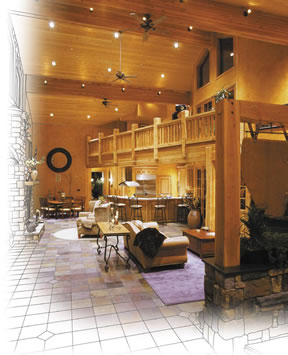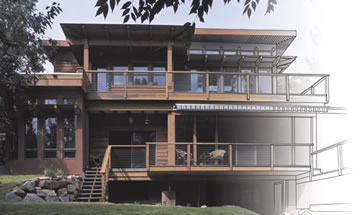
Vol. 14 No. 3 |
Winter 2004-05 |

 |
Green
by Design: Creating a Home for Sustainable Living, published
by Gibbs-Smith (www.gibbs-smith.com),
is available at most bookstores. To learn more about AMD Architecture,
call (801) 322-3053, or visit the firm’s Web site: www.amdarchitecture.com. |
As a young undergraduate in the University of Utah’s architecture program, Angela Dean BS’92 MArch’94 found herself learning the mechanics of architecture but longing for a deeper understanding, something beyond technical procedures and accepted norms. Outside classroom, she began exploring building practices across cultures and history and found herself drawn to what she calls more “humane” forms of space-making, commonly referred to as environmentally sustainable or “green” architecture.
Inspired by the idea that a prudent merger of time-tested and modern technologies can produce beautiful buildings while minimizing the detrimental effects of development, Dean became versed in green design. She traveled and studied the benefits using local materials, nontoxic building products and alternative energy sources. Her interest rapidly evolved into a passion that would shape her future and, possibly, the future of her chosen field.
“As architects, there’s so much we can do—good and bad—to impact [the environment],” explains Dean. “Given the responsibility of building out our world, we should really take it seriously. If you compare it to the medical profession, it’s like a doctor prescribing a medicine they really don’t know the effects of—just winging it and saying, ‘Well, we think this might work, so try it, and we’ll see what happens.’ That would be pretty irresponsible, but it’s often what happens in architecture. We sometimes don’t give a second thought as to how [our methods] affect us and our clients in the longer term, but we are responsible.”
In 1997, after cutting her professional teeth at larger firms, Dean founded AMD Architecture, a small Salt Lake City firm specializing in sustainable design. At just 28, she struck out on her own in a field dominated by men, all the while bucking the system by insisting on an unorthodox approach. It was a bold move, but running her own business was always her plan. While Dean had supportive mentors and coworkers at mainstream firms, she felt that, as a woman, contractors often didn’t take her seriously, assuming she was “just along to take notes.” Having made some connections in the industry, she decided it was time to establish a practice on her own terms—one that would preserve her professional integrity and allow her to surround herself with motivated clients and enlightened colleagues.
 Seven
years later, it seems the risk was worth it. Together with her assistant,
Chamonix Larsen BS’01 MArch’03, Dean maintains a steady flow
of work creating environmentally responsible buildings. A big believer
in education, she also promotes awareness through her involvement with
community groups and her book, Green by Design. “A lot
of people see it as a sort of altruistic effort to ‘save the world,’
” says Dean, “and while, yes, a huge part of it is improving
and sustaining the quality of our environment, it’s about our quality
of life, too—doing what’s best for us. Nobody wants to breathe
polluted air, drink polluted water or see ecosystems destroyed. So, it’s
really about looking at how we fit into the whole of life, as well as
how we can improve our own quality of life.”
Seven
years later, it seems the risk was worth it. Together with her assistant,
Chamonix Larsen BS’01 MArch’03, Dean maintains a steady flow
of work creating environmentally responsible buildings. A big believer
in education, she also promotes awareness through her involvement with
community groups and her book, Green by Design. “A lot
of people see it as a sort of altruistic effort to ‘save the world,’
” says Dean, “and while, yes, a huge part of it is improving
and sustaining the quality of our environment, it’s about our quality
of life, too—doing what’s best for us. Nobody wants to breathe
polluted air, drink polluted water or see ecosystems destroyed. So, it’s
really about looking at how we fit into the whole of life, as well as
how we can improve our own quality of life.”
Forget mass development and cookie-cutter floor plans. Dean views these trends as inhibitors to creativity that waste resources, encourage commuting and intensify urban encroachment on open space. But, she also believes the status quo in her field is temporary: “One day, people will wise up and realize that these places aren’t really pleasant to live in, that they’re sort of trapped.”
She sees that realization dawning in her clients, as well as in environmentally friendly marketing trends. “The general public is becoming more aware, whether it’s healthier lifestyles or healthy eating, and sustainable architecture fits within that realm of attention to well-being and quality of life issues. Once clients start asking more and more for those types of solutions, the design professionals will catch on, and suppliers and builders will follow suit when demand rises. I think it really has to come from the bottom up as a grassroots movement. Actually, I don’t even like to call it a ‘movement,’ because I think it’s just going to be the way we do business, once we understand it.”
Naturally, there are challenges in advocating a new direction. “There’s an aesthetic issue,” says Dean. “People think it’s going to look funny, and solar houses in the ’70s did. They were like modified chicken coops with a wall of glass.” Today, however, energy-efficient technology can be incorporated into any style of home. Cost and availability are also perceived barriers, but Dean contends that, with careful planning, an architect can obtain the necessary materials and labor while offsetting energy and maintenance costs down the road.
 Dean
sees herself as a facilitator more than an administrator. She advises
clients to reflect on spaces that have brought them joy while asking the
question “What does home mean to you?” The answers produce personal,
creative results. One family wanted to have their three daughters participate
in the construction of their vacation cabin. The house was to be built
of straw bale, so Dean helped plan bale-raising and plaster parties. “They
liked the idea of having the girls’ handprints in the plaster,”
she says, adding, “I like the hands-on, natural quality of owner-built
projects and empowering clients by putting the creation of their spaces
in their hands.”
Dean
sees herself as a facilitator more than an administrator. She advises
clients to reflect on spaces that have brought them joy while asking the
question “What does home mean to you?” The answers produce personal,
creative results. One family wanted to have their three daughters participate
in the construction of their vacation cabin. The house was to be built
of straw bale, so Dean helped plan bale-raising and plaster parties. “They
liked the idea of having the girls’ handprints in the plaster,”
she says, adding, “I like the hands-on, natural quality of owner-built
projects and empowering clients by putting the creation of their spaces
in their hands.”
Introspective and composed, Dean exudes a sense of purpose that is evident in every aspect of her life. She and her husband, Tim Brown ex’90, both feel strongly about living in harmony with the environment. In fact, Brown rents the office above Dean’s, where he runs the Center for Green Space Design, a nonprofit active in community master planning and open-space preservation. Brown is also an adjunct instructor for the U’s College of Architecture + Planning. “We feel fortunate to be able to work on similar paths,” says Dean.
As the parents of two small children, Phoebe and Max, the couple strives for balance by integrating work and family life. “That was one of my goals,” says Dean. “Looking ahead at how I wanted to raise a family, I wanted the flexibility to be independent and have some freedom to be there when I’m needed.” Her children are welcome at the office, and when they were babies, she frequently took them to meetings and work sites. “People would pass my son around,” Dean recalls. “Construction guys would hold him while I climbed a ladder or did whatever. I figure that’s real life, and if people can’t deal with it, that’s their problem. I know it’s raised some eyebrows, but that’s me, it’s part of the package.”
 Being
a mother also motivates Dean to stay on task. “Anyone who has kids
wants to be optimistic about the future,” she says, though she recognizes
it’s a tall order. “Some say it’s too late to rescue
the environment. Our built world impacts everything—transportation,
industry, pollution levels, energy production and consumption—it’s
all related to what we’re doing. It’s intimidating to think
about that responsibility, but I think there’s really no way out.
We have to make changes and progress.”
Being
a mother also motivates Dean to stay on task. “Anyone who has kids
wants to be optimistic about the future,” she says, though she recognizes
it’s a tall order. “Some say it’s too late to rescue
the environment. Our built world impacts everything—transportation,
industry, pollution levels, energy production and consumption—it’s
all related to what we’re doing. It’s intimidating to think
about that responsibility, but I think there’s really no way out.
We have to make changes and progress.”
And there is progress, not only on the level of the individual homeowner, but from the top down. The U.S. Green Building Council (www.usgbc.org), for example, has developed national ratings for green buildings. Dean is involved in local efforts to adopt those standards for city buildings and encourage private developers to follow suit. It’s all in keeping with her vision for herself and her firm. As Dean puts it, “You always need to look for a new and better way to do things. The research continues every day, and we are trying to find the right solutions. Sometimes it’s a battle and a struggle, but we’re stubborn that way.”
—Tiffini Porter Widlansky BS’96 is a free-lance writer
and former editorial assistant for Continuum.